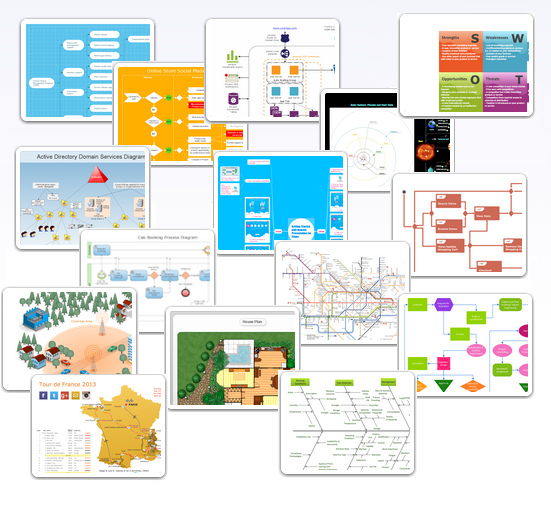Examples of Flowcharts, Org Charts and More
ConceptDraw DIAGRAM covers a broad spectrum of business graphics categories and offers at ConceptDraw STORE enormous online collection of pictorial examples and samples for different thematics and application areas. It is a plentiful source of inspiration and wonderful examples of professionally designed diagrams, flowcharts, UML diagrams, organizational charts, databases, ERDs, network diagrams, business charts, different thematic charts, schematics, infographics and plans developed specially for knowledge workers, engineers, managers, businessmen, marketing specialists, analytics, scientists, students, professors, journalists and also for a large number of other people that every day use various diagrams and drawings in their work and life activity. Each of these examples is a real art, all they are well thought-out and designed without efforts with help of powerful tools of ConceptDraw DIAGRAM software. ConceptDraw examples display all variety of tasks, possibilities and results that ConceptDraw Product Line lets achieve fast and easy. ConceptDraw is one of the best Visio alternatives for Mac. It open all Visio formats like.vsdx,.vss,.vdx files and allows you to export files to Visio formats.
 Computer Network Diagrams
Computer Network Diagrams
Computer Network Diagrams solution extends ConceptDraw DIAGRAM software with samples, templates and libraries of vector icons and objects of computer network devices and network components to help you create professional-looking Computer Network Diagrams, to plan simple home networks and complex computer network configurations for large buildings, to represent their schemes in a comprehensible graphical view, to document computer networks configurations, to depict the interactions between network's components, the used protocols and topologies, to represent physical and logical network structures, to compare visually different topologies and to depict their combinations, to represent in details the network structure with help of schemes, to study and analyze the network configurations, to communicate effectively to engineers, stakeholders and end-users, to track network working and troubleshoot, if necessary.
- 4 Level pyramid model diagram - Information systems types | 5 Level ...
- Flowchart on Bank . Flowchart Examples | Bank social media ...
- Sketch Of Classification Information Systems
- Bank System Flow Chart
- Information Management System Flow Chart With Example Pdf
- Flowchart on Bank . Flowchart Examples | Process Flowchart | How ...
- Process Flowchart | Bank social media response flowchart ...
- Flowchart on Bank . Flowchart Examples | Accounting Flowcharts ...
- Flowchart on Bank . Flowchart Examples | Flowchart Examples and ...
- Flowchart on Bank . Flowchart Examples | Bank social media ...
- UML use case diagram - Banking system | Banking System | UML for ...
- Swim Lane Flowchart Symbols | Design elements - Bank UML ...
- Flowchart on Bank . Flowchart Examples | Process Flowchart | How ...
- Flowchart on Bank . Flowchart Examples | Process Flowchart ...
- Flowchart on Bank . Flowchart Examples | Process Flowchart | How ...
- PM Docs | Bank UML Diagram | Banking System | Types Of Bank ...
- Process Flowchart | Flowchart on Bank . Flowchart Examples | Bank ...
- Flowchart on Bank . Flowchart Examples | Social Media Response ...
- Tree Diagram Of Classification Of Manufacturing Sydtem
- Process Flowchart | Flowchart on Bank . Flowchart Examples | LLNL ...
